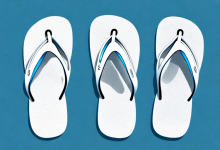Trail running is an increasingly popular sport that involves running or jogging, typically on unpaved paths. In order to have the best experience and prevent injury, it is important to have the right type of footwear for the job. While running shoes can be perfect for some, there’s a growing subset of trail runners that are turning to more lightweight and lesser-known gear, like hiking sandals.
The Benefits of Hiking Sandals
Hiking sandals offer a variety of advantages for the trail runner. First and foremost, they’re usually lightweight and comfortable. They also tend to have better drainage than closed-toe shoes, allowing water that would otherwise accumulate to escape, which helps reduce wetness and make cleaning up afterwards easier. The open-toed design allows air to circulate, which is important for keeping your feet cool in warmer weather. Lastly, sandals are often much cheaper than full-on running shoes, making them a great option if you’re on a budget.
Pros and Cons of Using Hiking Sandals for Trail Running
Like any piece of gear, hiking sandals come with both pros and cons. On the plus side, they’re comfortable and lightweight, so you don’t have to carry as much with you on the trail. Sandals also offer excellent breathability and aeration, keeping your feet dry even during long runs. They can be much cheaper than traditional running shoes, too. On the downside, sandals lack the support of more structured running shoes, leaving your feet more exposed to stones, sticks, and other obstacles on the trail.
Types of Hiking Sandals
Hiking sandals are available in different styles and materials. Traditional hiking sandals generally consist of a single piece of upper material with straps around your foot that fasten with velcro. They usually offer excellent ventilation, but the lack of padding can lead to discomfort over time. On the other hand, hybrid sandals—which often have an integrated sole and a mixture of straps and laces for support—are designed for more rigorous runs.
Tips for Choosing the Right Hiking Sandal
When selecting hiking sandals for trail running, look for models that provide adequate cushioning, arch support, and stability. The bottoms should be rigid enough to guarantee good grip while avoiding slips on wet terrain. It’s also important to make sure your sandals fit properly and don’t slip around while running. Pay attention to the type of terrain you’re running on, as well. Sticky rubber soles are best for muddy feet while knobby soles are best for rocky terrain.
How to Choose the Right Trail Running Shoe
It’s important to find the right trail running shoe for your feet, as well. You want a shoe that offers ample cushioning and provides protection from rocks and other obstacles. Make sure it fits properly and doesn’t cause any irritations. Look for features like grippy lugs for extra traction, soft midsoles, wide toe boxes for extra comfort and roominess, and breathable uppers. Don’t overlook waterproofing either!
What to Consider Before Buying Trail Running Shoes
Before you buy running shoes for trail use, consider the type of terrain you’ll be covering. Research different brands and models of shoes to find one that suits your budget and offers features like breathability, adequate cushioning and stability, water-resistant or waterproof materials, and heavyweight lugs or treads for better grip on rocky or muddy ground. Don’t forget to take a look at reviews online or ask other runners in order to get an unbiased opinion.
Safety Tips for Trail Running with Hiking Sandals
When running on trails with hiking sandals, here are some safety tips you should keep in mind: Stay aware of your surroundings as you run; watch out for rocks, sticks, roots, and other objects that could trip you up; wear bright-colored clothing; use sun protection; stay hydrated; stick to trails that are suitable for your skill level; bring a spare pair of dry shoes with you; carry a light source like a headlamp or flashlight; and never run alone.
Common Mistakes to Avoid When Wearing Hiking Sandals for Trail Running
There are certain mistakes to avoid when wearing hiking sandals for trail running. For example, don’t use too much speed when running downhill, as this can push your feet back too much and cause pain. Additionally, avoid putting too much pressure on the ball of your feet when running on softer terrain. Always be aware of where your feet are going, as some trails may be more slippery than others. Lastly, if you’re carrying a heavy pack while running with sandals, make sure the weight is properly balanced.
Conclusion
Hiking sandals offer a lightweight and comfortable option for trail running. Choosing the right sandal requires you to consider factors like cushioning, arch support, air circulation and ventilation. If done correctly, using hiking sandals can provide many benefits such as comfort and better drainage. Just be sure to follow the safety tips mentioned above when running in sandals.



